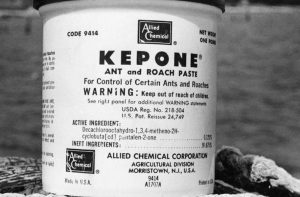Posted on March 28, 2024 by Dennis H. Treacy

Fifty years ago the Commonwealth of Virginia experienced a human health and environmental crisis when the insecticide Kepone was discovered in the blood of manufacturing workers and in the fish and sediment of the James River at Hopewell Virginia. For those of us who participated on response teams the memories are vivid. But most have forgotten or never knew the fearful moments about a chemical that gave workers the “Kepone shakes” and closed commercial fishing in the James River for 13 years. As a young biologist working for the state environmental agency I was involved with environmental response teams that sampled sediments and fish in the river. I will never forget that period in my life and career.
As I think of lessons learned from that experience there are many, but one stands out. In the federal court case against the producer of Kepone Judge Robert Merighe levied a $13.24 million fine (according to the Richmond Times Dispatch that fine would be about 75 million dollars today) as part of the criminal penalty against the manufacturer of Kepone. Of that amount he set aside 8 million dollars to create the Virginia Environmental Endowment (VEE), an organization that is still going strong today. The judge’s move was revolutionary at the time because all environmental fines were required to be paid to the United States Treasury. The judicial assignment of this money to a created organization that provided grants to Virginia environmental organizations was unprecedented. He also appointed the initial VEE board members. The Judge’s decision survived the test of time. One could argue that VEE was a precursor to modern day Supplemental Environmental Projects (SEP). Over the years the VEE provided funds to create or strengthen the Chesapeake Bay Foundation, the Environmental Defense Fund, Southern Environmental Law Center (SELC), the James River Association, Virginia Forever, and many many more Virginia organizations, large and small, dedicated to environmental protection.
I suggest that practitioners and law professors read the recent summary of the Kepone crisis in the Richmond Times Dispatch, and two recent books on the topic. The first is a book funded in part by the VEE and written by Gregory S. Wilson, a past fellow with Virginia Humanities, who did not want the Kepone crisis to be forgotten. Poison Powder; The Kepone Disaster in Virginia and Its Legacy, The University of Georgia Press (2023), is a detailed blow by blow account of the Kepone crisis and the author’s exhaustive research resulted in a book that has a complete historical account of the Kepone crisis. The second is a book by Gerald P. McCarthy, the first executive director of the VEE, entitled Blueprint for Going Green; How a Small Foundation Changed the Model for Environmental Conservation, University of Virginia Press (2024). Mr. McCarthy’s book details the creation of VEE and describes the internal decision making process for grant making at the organization. The book contains a description of the many environmental grants that have been made by VEE over the last five decades. It is replete with little known back stories that would have been lost but for Mr. McCarthy’s effort.
The lesson learned for environmental lawyers is to always offer innovative and creative remedies in tough cases. The payoff could be huge.
